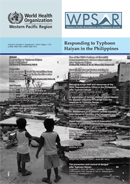A snapshot of catastrophic post-disaster health expenses after Typhoon Haiyan
DOI:
https://doi.org/10.5365/wpsar.2015.6.2.HYN_017Abstract
Introduction: This paper provides a snapshot of the health-care costs, out-of-pocket expenditures and available safety nets post-Typhoon Haiyan.
Methods: This descriptive study used a survey and document review to report direct and indirect health-care costs and existing financial protection mechanisms used by households in two municipalities in the Philippines at one week and at seven months post-Haiyan.
Results: Reported out-of-pocket health-care expenses were high immediately after the disaster and increased after seven months. The mean reported out-of-pocket expenses were higher than the reported average household income (US$ 24 to US$ 59).
Discussion: The existing local and national mechanisms for health financing were promising and should be strengthened to reduce out-of-pocket expenses and protect people from catastrophic expenditures. Longer-term mechanisms are needed to ensure financial protection, especially among the poorest, beyond three months when most free services and medicines have ended. Preparedness should include prior registration of households that would ensure protection when a disaster comes.

